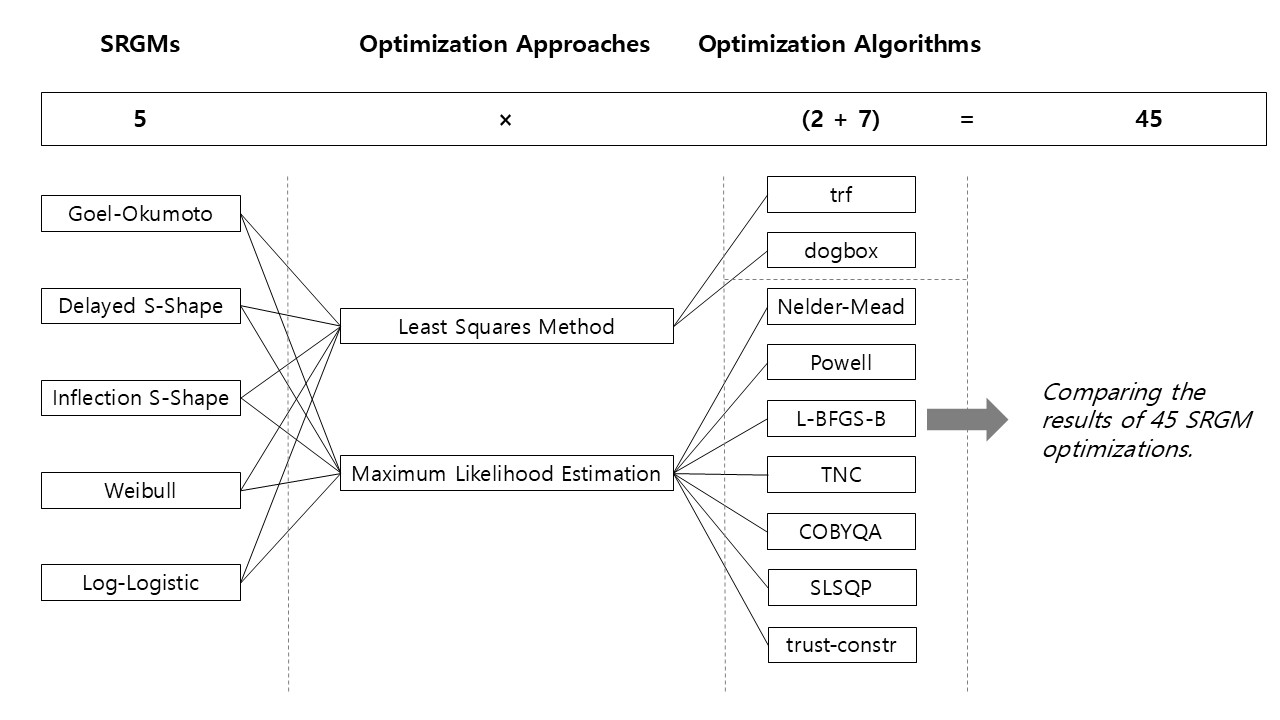Optimization based machine learning algorithms for software reliability growth models
DOI:
https://doi.org/10.37944/jams.v8i1.275Keywords:
software reliability, software reliability growth model, artificial intelligence optimization, machine learningAbstract
Software reliability is a critical factor for system performance and safety, especially in defense industries, where operational failures can have severe consequences. To evaluate and improve software reliability, Software Reliability Growth Models (SRGMs) are widely used. However, many previous studies have relied on single optimization methods or deep learning approaches, which are prone to local optima and extrapolation issues, reducing prediction accuracy. To fill this gap, current study employs a broader range of optimization algorithms based on the Least Squares Method (LSM) and Maximum Likelihood Estimation (MLE) to approximate global optima. NASA’s Jet Propulsion Laboratory (JPL) software defect datasets were used, and several widely recognized SRGM models, including Goel-Okumoto, Delayed S-Shape, Inflection S-Shape, Weibull, and Log-Logistic, were evaluated. Experimental results show that the choice of optimization method significantly affects prediction performance, as measured by Mean Squared Error (MSE). For example, in the J2 dataset, the Weibull model exhibited MSE values ranging from 70.778 to 15,767.68—a 222-fold difference—demonstrating the critical role of optimization in prediction accuracy. The findings confirm the risks of relying solely on single-method approaches and highlight the value of diverse optimization strategies for achieving near-global optima. The study presents a practical framework for improving software reliability assessments, contributing to the development of highly reliable software for the defense industry.
Metrics
References
Bahnam, B. S., Dawwod, S. A., & Younis, M. C. (2024). Optimizing software reliability growth models through simulated annealing algorithm: parameters estimation and performance analysis. The Journal of Supercomputing, 80(11), 16173-16201. https://doi.org/10.1007/s11227-024-06046-4
Chatterjee, S., Saha, D., & Sharma, A. (2021). Multi‐upgradation software reliability growth model with dependency of faults under change point and imperfect debugging. Journal of Software: Evolution and Process, 33(6), e2344. https://doi.org/10.1002/smr.2344
Cho, Y., Min, S., Lim, S., & Choi, K. (2023). A study on the differences in the perceived importance of jet fighter performance improvement factors. Journal of Advances in Military Studies, 6(2), 17-41. https://doi.org/10.37944/jams.v6i2.192
Dhavakumar, P., & Gopalan, N. P. (2021). An efficient parameter optimization of software reliability growth model by using chaotic grey wolf optimization algorithm. Journal of Ambient Intelligence and Humanized Computing, 12, 3177-3188. https://doi.org/10.1007/s12652-020-02476-z
Goel, A. L., & Okumoto, K. (1979). Time-dependent error-detection rate model for software reliability and other performance measures. IEEE Transactions on Reliability, R-28(3), 206-211. https://doi.org/10.1109/TR.1979.5220566
Gokhale, S. S., & Trivedi, K. S. (1998). Log-logistic software reliability growth model. In Proceedings of the Third IEEE International High-Assurance Systems Engineering Symposium (pp. 34-41). IEEE.
Hur, Y. (2024). Exploring the critical factors of depot maintenance on weapon systems in South Korea. Journal of Advances in Military Studies, 7(3), 1-12. https://doi.org/10.37944/jams.v7i3.271
IEEE Reliability Society. (2017). IEEE Std. 1633-2016 - IEEE recommended practice on software reliability. IEEE. https://doi.org/10.1109/IEEESTD.2017.7827907
Jin, C., & Jin, S. (2016). Parameter optimization of software reliability growth model with S-shaped testing-effort function using improved swarm intelligent optimization. Applied Soft Computing, 40, 283-291. https://doi.org/10.1016/j.asoc.2015.11.041
Kanoun, K., & Laprie, J. C. (1994). Software reliability trend analyses from theoretical to practical considerations. IEEE Transactions on Software Engineering, 20(9), 740-747. https://doi.org/10.1109/32.317434
Kenney, G. Q. (1993). Estimating defects in commercial software during operational use. IEEE Transactions on Reliability, 42(1), 107-115. https://doi.org/10.1109/24.210280
Kim, Y. S., Pham, H., & Chang, I. H. (2023). Deep-learning software reliability model using SRGM as activation function. Applied Sciences, 13(19), 10836. https://doi.org/10.3390/app131910836
Kim, T., Ryu, D., & Baik, J. (2024). Automated Machine Learning for Enhanced Software Reliability Growth Modeling: A Comparative Analysis with Traditional SRGMs. 2024 IEEE 24th International Conference on Software Quality, Reliability and Security (QRS) (pp. 483-493) https://doi.org/10.1109/QRS62785.2024.00055
Kim, Y., Kim, D., & Jeong, D. (2024). Feasibility and foundational elements of CBM+ technology application in weapon systems. Journal of Advances in Military Studies, 7(2), 29-54. https://doi.org/10.37944/jams.v7i2.243
Oh, J. W., Eom, W. Y., Chae, S. Y., Cho, H. B., & Chang, J. H. (2024). A Study of Feedback Method for Weapon System Software Defection Analysis based on Software Risk Analysis. Journal of Korea Academia-Industrial cooperation Society, 25(6), 371-377. https://doi.org/10.5762/KAIS.2024.25.6.371
Ohba, M. (1984). Inflection S-shaped software reliability growth model. In S. Osaki & Y. Hatoyama (Eds.), Stochastic Models in Reliability Theory (Vol. 235, pp. 144-162). Springer.
Samal, U. (2024). Software Reliability Growth Model Considering Imperfect Debugging and Fault Removal Efficiency. Quality and Reliability Engineering International, 41(4), 1268-1278. https://doi.org/10.1002/qre.3716
Samal, U., & Kumar, A. (2024). Metrics and trends: a bibliometric approach to software reliability growth models. Total Quality Management & Business Excellence, 35(11-12), 1274-1295. https://doi.org/10.1080/14783363.2024.2366510
Sung, S. I., Yoon, H. J., & Lim. J. H. (2021). Considerations on Laws and Regulations for Improving the Reliability of Weapons Systems: Based on the Reliability Growth Model. Journal of Applied Reliability, 21(2), 181-189. https://doi.org/10.33162/JAR.2021.6.21.2.181
Virtanen, P., et al. (2020). SciPy 1.0: Fundamental algorithms for scientific computing in Python. Nature Methods, 17, 261–272. https://doi.org/10.1038/s41592-019-0686-2
Wang, J., & Zhang, C. (2025). Optimization Selection Method for Software Reliability Growth Model Based on Cosine Similarity. Journal of Systems and Software, 228, 112474. https://doi.org/10.1016/j.jss.2025.112474
Yamada, S., & Osaki, S. (1985). Software reliability growth modeling: Models and applications. IEEE Transactions on Software Engineering, SE-11(12), 1431-1437. https://doi.org/10.1109/TSE.1985.232179
Yamada, S., Onba, M., & Osaki, S. (1983). S-shaped reliability growth modeling for software error detection. IEEE Transactions on Reliability, R-32(5), 475-484. https://doi.org/10.1109/TR.1983.5221735

Downloads
Published
How to Cite
Issue
Section
License
Copyright (c) 2025 Journal of Advances in Military Studies

This work is licensed under a Creative Commons Attribution 4.0 International License.

This work is licensed under a Creative Commons Attribution 4.0 International License.

이 저작물은 크리에이티브 커먼즈 저작자표시 4.0 국제 라이선스에 따라 이용할 수 있습니다.






